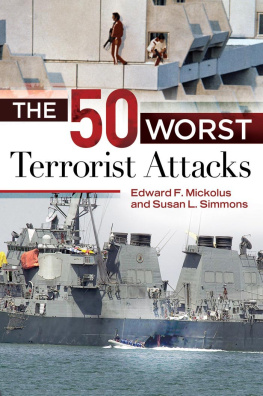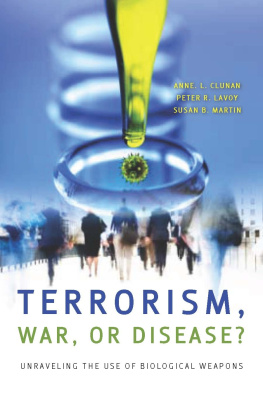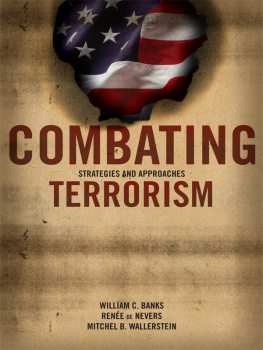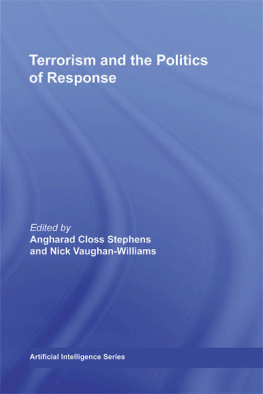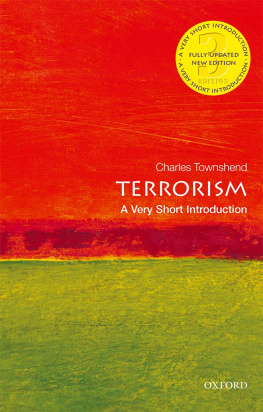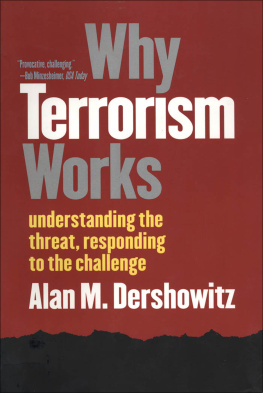Edward Mickolus - Terrorism, 2008-2012
Here you can read online Edward Mickolus - Terrorism, 2008-2012 full text of the book (entire story) in english for free. Download pdf and epub, get meaning, cover and reviews about this ebook. year: 2014, publisher: McFarland, genre: Politics. Description of the work, (preface) as well as reviews are available. Best literature library LitArk.com created for fans of good reading and offers a wide selection of genres:
Romance novel
Science fiction
Adventure
Detective
Science
History
Home and family
Prose
Art
Politics
Computer
Non-fiction
Religion
Business
Children
Humor
Choose a favorite category and find really read worthwhile books. Enjoy immersion in the world of imagination, feel the emotions of the characters or learn something new for yourself, make an fascinating discovery.
- Book:Terrorism, 2008-2012
- Author:
- Publisher:McFarland
- Genre:
- Year:2014
- Rating:3 / 5
- Favourites:Add to favourites
- Your mark:
- 60
- 1
- 2
- 3
- 4
- 5
Terrorism, 2008-2012: summary, description and annotation
We offer to read an annotation, description, summary or preface (depends on what the author of the book "Terrorism, 2008-2012" wrote himself). If you haven't found the necessary information about the book — write in the comments, we will try to find it.
Terrorism, 2008-2012 — read online for free the complete book (whole text) full work
Below is the text of the book, divided by pages. System saving the place of the last page read, allows you to conveniently read the book "Terrorism, 2008-2012" online for free, without having to search again every time where you left off. Put a bookmark, and you can go to the page where you finished reading at any time.
Font size:
Interval:
Bookmark:

20082012

McFarland & Company, Inc., Publishers
Jefferson, North Carolina
LIBRARY OF CONGRESS CATALOGUING DATA ARE AVAILABLE
BRITISH LIBRARY CATALOGUING DATA ARE AVAILABLE
e-ISBN: 978-1-4766-1467-0
2013 Edward Mickolus. All rights reserved
No part of this book may be reproduced or transmitted in any form or by any means, electronic or mechanical, including photocopying or recording, or by any information storage and retrieval system, without permission in writing from the publisher.
Cover images 2014 Thinkstock
McFarland & Company, Inc., Publishers
Box 611, Jefferson, North Carolina 28640
www.mcfarlandpub.com
To the people
who devote their lives to
keeping everyone else safe
With the publication of this volume, I, singly or in tandem, have written some twenty chronologies of terrorism and biographies of terrorists in the past three-plus decades. While I have hoped that each volume would be the last in the series, individuals willing to follow their fellow thugs into these pages continue to come forward.
Using a comprehensive definition, this chronology considers terrorism to be the use or threat of use of violence by any individual or group for political purposes. The perpetrators may be functioning for or in opposition to established governmental authority. A key component of international terrorism is that its ramifications transcend national boundaries, and, in so doing, create an extended atmosphere of fear and anxiety. The effects of terrorism reach national and worldwide cultures as well as the lives of the people directly hurt by the terrorist acts. Violence becomes terrorism when the intention is to influence the attitudes and behavior of a target group beyond the immediate victims. Violence becomes terrorism when its location, the victims, or the mechanics of its resolution result in consequences and implications beyond the act or threat itself.
The period 2008 to 2012 saw the continuation of trends identified in previous years, although it also saw the failure of some long-held analytic predictions. Some predictions were made by pundits who are paid for spouting opinions and issuing slogans masquerading as insights and not for developing understanding. But others were made by respected academics who look at patterns from history and might miss the black swan problem noted by Nassim Nicholas Taleb, such as the 9/11 attacks.
Most attacks continue to be low-level, unsophisticated bombings and shootings with terrorists going after targets of opportunity rather than mounting complex operations that are the stuff of Hollywood movies and novels. Some operations, most notably the three-day siege of Mumbai by jihadis in November 2008 and the takeover of an Algerian gas production facility in January 2013, underscore that not all terrorists opt for the easy hit.
Al Qaeda affiliates made kidnapping into a mobile murder rather than the barricade-and-hostage method it had been in the 1970s and 1980s.
We can put to bed the myth that has become common knowledge among the commentariat about terrorist behavior and anniversary dates. Despite media certainty, there is no evidence that terrorists conduct follow-up attacks on religious holidays, holidays for the targets nationalities, feast days of major terrorists, arrest dates of terrorists, or anniversaries of terrorist events. Al Qaeda has conducted no further attacks on, say, September 11 (anniversary of 9/11), July 7 (anniversary of the London subway attacks), or March 11 (anniversary of the Madrid train attacks). Pundits celebrate anniversary dates; terrorists do not. Terrorists know that the media will herald an upcoming date, and security services, heeding the counsel of their public affairs offices, will put on a display of preventive zeal. All for naught. Terrorists attack on the date that they believe will work now, not one that worked in the past.
Much was made of the coincidental date of the attack on the U.S. diplomatic facility in Benghazi, Libya, on September 11, 2012, in which four U.S. diplomats, including the U.S. ambassador, were murdered. With tens of thousands of terrorist attacks having been logged during the period covered by this chronology series, date overlap is unavoidable. It is noteworthy that although Islamists were credited with the attack, none of the groups claiming credit cited any link to the September 11, 2001, attacks. Moreover, there was no evidence of involvement by al Qaeda, per se.
Al Qaeda continued its transformation from a tightly controlled organization bowing to the whims of one individual to a loose confederation of like-minded jihadi zealots. On occasion, al Qaeda centralthe group immediately surrounding Osama bin Laden and Ayman al-Zawahiri, plus the al Qaeda operations chief of the day (they keep getting killed)bequeaths associate status on a franchise and permits it to use the al Qaeda brand. Hence, the growth of al Qaeda in the Islamic Maghreb, al Qaeda in the Arabian Peninsula (AQAP), and al Qaeda in Iraq (AQI). Although al-Shabaab in Somalia has not adopted the al Qaeda name, it, too, seems to have acquired second circle status. Other groups with close ties to al Qaeda, including Jemaah Islamiyah in Indonesia and Abu Sayyaf in the Philippines, have yet (at least, as of this writing) to obtain formal franchise status. Similarly, despite the similarity of their stated goals and interconnections of its membership, al Qaeda has not included the Chechens, Islamic Movement of Uzbekistan, or Uighurs as formal franchise spinoffs. Still other wannabes travel to the caves and training centers of al Qaeda to seek weapons, training, and the blessing of the core group.
Among theses wannabes has been a disturbing number of American citizens, many of them Western-looking and American-accented radicals steeped in U.S. culture and able to move more easily in the American environment. While excellent law enforcement work has led to the arrests and imprisonment of dozens of these individuals, it is clear that al Qaeda continues to believe that the Westernization of its operational cadre offers opportunities for attacks on the far enemythe U.S. homeland.
The question of what to do with terrorists plagued the Bush and Obama administrations during this period. Media upset over interrogation methods and incarceration procedures led to calls for a catch-and-release policy, changes to questioning methods (on the dubious proposition that terrorists would commit themselves to similar limitations on their handling of hostages), and a shift to kinetic responses. Air strikes took out many leaders of al Qaeda central and its affiliates in Yemen, while scores were released from Guantanamo Bay military prison. Still others awaited trial as judicial scholars and other observers pondered whether a military or civilian court was the more appropriate forum. Several released from Guantanamo Bay to their home governments, who ultimately declared them no longer a threat, soon became leaders of terrorist organizations, with membership in the Gitmo alumni association giving instant street credibility among their brethren.
Aspects of the detainees defenses continued to divert media attention. Many of the Guantanamo detainees claimed, in essence, that their training in al Qaeda camps in then Taliban-governed Afghanistan was a mere praycation, not terrorist-related. Others, most notably the high value detainees such as Khalid Sheikh Muhammad, Mustafa Ahmad al-Hawsawi, and Ramzi Binalshibh, attempted to make their hearings an opportunity to spout their propaganda rather than offer a true defense of their actions.
Next pageFont size:
Interval:
Bookmark:
Similar books «Terrorism, 2008-2012»
Look at similar books to Terrorism, 2008-2012. We have selected literature similar in name and meaning in the hope of providing readers with more options to find new, interesting, not yet read works.
Discussion, reviews of the book Terrorism, 2008-2012 and just readers' own opinions. Leave your comments, write what you think about the work, its meaning or the main characters. Specify what exactly you liked and what you didn't like, and why you think so.


